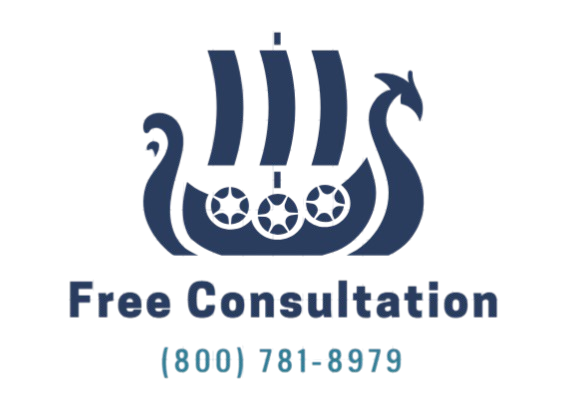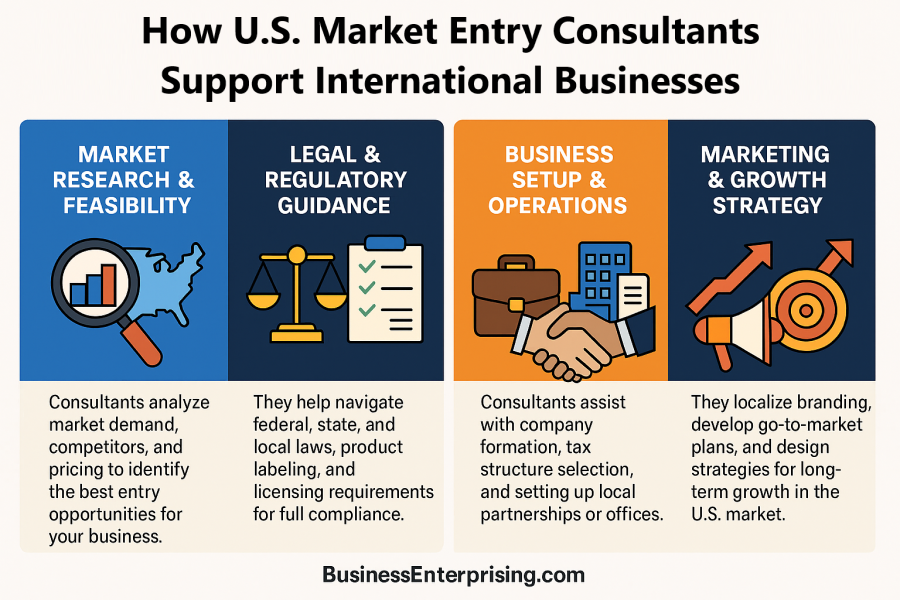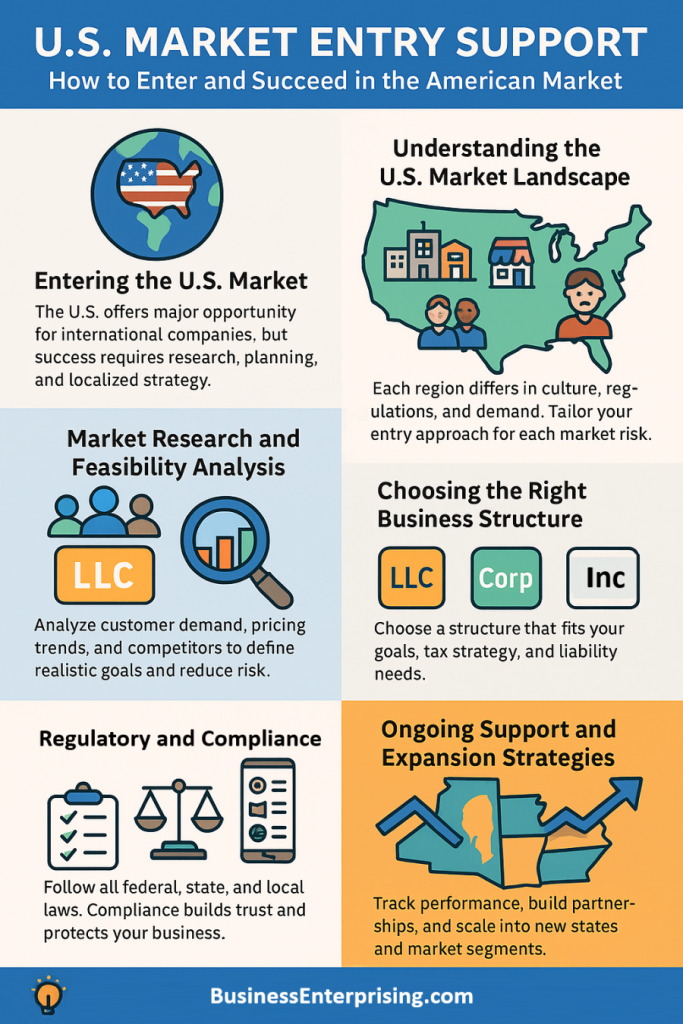
Additionally, the U.S. market offers unmatched opportunity for companies ready to adapt. Each state has its own culture, economy, and business regulations, which means localized strategies often work best. Therefore, researching regional trends and consumer habits can help you identify where your products or services will perform strongest. With the right preparation, you can enter confidently and make decisions that align with your long-term business goals.
Furthermore, success in the U.S. depends on more than an appealing product. You need the right structure, compliance knowledge, and marketing strategy to stand out. A well-planned entry strategy connects all these elements, helping you balance growth with sustainability. Therefore, companies that invest time in understanding their target markets tend to build stronger brand presence and customer trust.
The U.S. remains one of the most rewarding markets for international expansion. However, success requires patience, data-driven insight, and professional guidance. By approaching entry strategically and working with experienced partners, your business can establish itself, grow steadily, and compete effectively across a diverse and dynamic economy.
Understanding the U.S. Market Landscape
The United States represents one of the largest and most complex markets in the world. Its economy is diverse, driven by innovation, and supported by a strong consumer base. However, this size and diversity create both opportunities and challenges for companies looking to enter. Each region, state, and city operates with its own customer preferences, cultural influences, and business regulations. Therefore, understanding these differences is key to creating a strong and sustainable market presence.
Additionally, the U.S. market operates under a layered regulatory system that includes federal, state, and local requirements. These rules can affect how products are labeled, marketed, and distributed. Because of this, foreign companies often benefit from guidance or professional US market entry support to help interpret compliance standards and reduce risk. By learning the expectations of each region and industry, your business can avoid costly mistakes and build trust with customers.
The competitive nature of the U.S. market also sets it apart. Thousands of brands compete across similar industries, which makes differentiation essential. Therefore, you must position your business with a clear value proposition that resonates with American consumers. Success depends on understanding not only what customers buy but also why they buy it.
Furthermore, a one-size-fits-all strategy rarely works in such a varied marketplace. Each state and demographic may respond differently to pricing, branding, and distribution methods. Tailoring your approach improves your ability to connect with customers and adapt to regional trends. With careful research and strategic planning, your entry into the U.S. market can lead to meaningful and lasting growth.
Market Research and Feasibility Analysis
Market research and feasibility analysis form the foundation of any successful entry into the United States. Before investing in marketing or distribution, you need to understand the demand for your products or services. Thorough research helps identify who your target customers are, what they value, and how they make purchasing decisions. Therefore, detailed analysis helps you position your brand effectively and align your offerings with market expectations.
Additionally, understanding pricing trends plays a key role in shaping your strategy. Each industry has different price sensitivities and consumer behaviors that influence how products perform. By studying competitors and their market share, you gain insight into what drives success and where gaps may exist. Therefore, this information allows you to adjust pricing and marketing approaches to create a competitive advantage.
Furthermore, regional differences across U.S. states can significantly impact performance. Consumer preferences vary by geography, income level, and culture. What sells well in California may not appeal to customers in Texas or New York. Therefore, adapting your marketing and sales strategies to local needs increases the likelihood of acceptance and growth.
US market entry support services can guide you through this process, providing localized insights that improve your decisions. By combining data-driven analysis with practical market knowledge, you reduce risk and strengthen your entry plan. Market research does more than identify opportunity—it shapes your strategy, helps define your audience, and builds a roadmap for long-term success in the United States.
Choosing the Right Business Structure
Choosing the right business structure is one of the most important decisions when entering the U.S. market. The structure you select affects taxes, legal liability, and management flexibility. Therefore, it’s essential to choose one that supports your long-term goals and aligns with your operational needs. Each option, from limited liability companies to corporations and partnerships, offers different advantages and obligations.
An LLC, or limited liability company, is often preferred by foreign businesses for its flexibility and simplicity. It protects personal assets while offering pass-through taxation, which means profits are taxed at the individual level rather than the corporate level. Additionally, it requires less formal management than a corporation, making it easier for smaller companies to operate. However, it still provides the credibility and structure needed to do business in the U.S.
A corporation offers more formality and can attract investors more easily. It provides strong liability protection and allows for stock ownership. Therefore, it’s often used by companies seeking long-term growth or outside investment. On the other hand, partnerships are simpler but come with shared liability among owners. They work best for small ventures or businesses with trusted local partners.
US market entry support professionals can help you evaluate these structures and their implications. Each option affects how you pay taxes, manage ownership, and handle compliance requirements. By analyzing your business goals, risk tolerance, and investment strategy, you can select a structure that supports stable growth. Making this choice early helps you avoid complications later and build a foundation that fits your U.S. operations.
Regulatory and Compliance Requirements
Regulatory and compliance requirements play a major role in determining how your business operates within the United States. Each level of government—federal, state, and local—has its own rules that may apply to your products or services. Therefore, understanding these laws before entering the market helps you avoid penalties and delays. Compliance begins with knowing which regulations affect your business and how to meet them consistently.
Additionally, product labeling is one of the most common areas where foreign companies make mistakes. Labels must follow specific rules about language, measurements, and ingredient disclosure. Import regulations also vary depending on your product category and origin country. Therefore, you should confirm that your packaging, documentation, and distribution practices meet customs and trade requirements before shipment. This preparation protects your goods from being delayed or rejected at entry points.
Data protection has also become a priority across U.S. industries. Companies collecting consumer information must follow privacy standards that vary by state. For example, some regions require clear consent for data use or allow customers to opt out of sharing information. Therefore, reviewing your data management policies early helps you maintain compliance and customer trust.
Furthermore, some industries require professional or operational licenses before you can begin business activity. These include healthcare, food services, construction, and financial services. US market entry support specialists can help identify which permits apply to your business and how to secure them efficiently. By prioritizing compliance, you protect your reputation, build credibility, and create a stable foundation for long-term success in the U.S. market.
Go-to-Market Strategy and Localization
A strong go-to-market strategy helps you connect your brand with the right audience in the United States. Success depends on how well your company adapts to American consumer preferences and buying habits. Therefore, localization is more than translation; it’s about reshaping your brand’s voice, visuals, and marketing approach to resonate with regional expectations. Every element, from product packaging to digital communication, should feel authentic and relatable to U.S. customers.
Additionally, your messaging should reflect local values, lifestyles, and communication styles. American consumers tend to respond to clarity, trust, and emotional connection. Therefore, you should refine your brand story to highlight benefits that matter most to your target demographic. Consistent branding across websites, social media, and advertising channels helps build recognition and loyalty. Digital marketing plays a key role, using SEO, content creation, and paid ads to reach potential customers effectively.
Distribution strategy also matters. Selecting the right mix of retail, e-commerce, and direct sales channels depends on your product type and customer behavior. For example, online platforms offer broader reach, while retail partnerships provide credibility and visibility. Therefore, you should balance both to maximize exposure and accessibility. Efficient logistics, including warehousing and shipping, support timely delivery and positive customer experiences.
US market entry support services can guide you through localization decisions and sales channel selection. By understanding how regional differences influence buying patterns, you can tailor your approach for stronger results. A well-designed go-to-market plan helps your brand enter confidently and grow sustainably within the competitive U.S. marketplace.
Ongoing Support and Expansion Strategies
Ongoing support after entering the U.S. market is essential for maintaining consistent growth and improving performance. Your initial launch is only the first phase of a long-term expansion process. Therefore, continuous evaluation helps you identify new opportunities, address challenges, and strengthen your market position. Regular performance tracking allows you to assess sales results, customer feedback, and return on marketing investments. By reviewing these insights, you can refine your strategies and adapt quickly to changing market conditions.
Additionally, partnership development plays a major role in sustaining growth. Building relationships with distributors, local suppliers, and marketing partners expands your reach and credibility. Strategic collaborations can open doors to new customer segments or regional markets. Therefore, maintaining active communication with your partners helps align business goals and promotes steady expansion. Developing these connections can also make operations more efficient and increase brand visibility across competitive sectors.
Furthermore, scaling your business into new states or product categories requires careful planning. Each region in the U.S. has different consumer habits, taxes, and regulations. Therefore, your approach must balance consistency with local flexibility. US market entry support specialists can assist by identifying regional trends and managing the operational requirements for expansion. This guidance helps you move forward without unnecessary delays or compliance risks.
Sustained success depends on staying proactive and adaptable. By tracking performance, nurturing partnerships, and expanding strategically, you build a foundation for long-term stability. With the right post-entry support, your business can continue growing and thriving across the United States.
Conclusion
Expanding into the United States offers strong potential for growth, but success depends on careful planning and consistent adaptation. Each stage of the process, from research to operations, requires attention to detail and a willingness to adjust. Therefore, understanding your market, building strong partnerships, and staying compliant with regulations are essential for long-term stability. Entering the U.S. market is not a single event but a structured process that evolves as your business grows.
Additionally, investing time in localization helps your brand connect with diverse audiences across regions. Every state and demographic group has unique preferences and expectations. Therefore, customizing your marketing and distribution strategies strengthens your relationship with American consumers. Over time, small adjustments in communication, pricing, or service can lead to lasting trust and brand loyalty.
Furthermore, ongoing performance analysis helps you measure success and find opportunities for improvement. By tracking progress, you can refine strategies that drive sustainable results. US market entry support services provide guidance throughout this process, helping you make informed decisions and expand effectively.
Ultimately, the U.S. market rewards businesses that approach growth strategically. With the right preparation, compliance, and support, your company can achieve meaningful results. Entering this market requires patience, but with a clear plan and continued focus, your efforts can lead to long-term success and a strong competitive presence.


